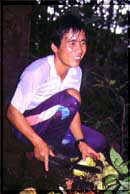 |
Harvesting
Durians. Sopinggi
Ladsou, mountain guide
and enthusiastic
community ethnobotanist,
preparing fruits of Durio
kinabaluensis,
(Bombaceae) in the
community forest reserve
of Kampung Kiau Nuluh,
Sabah, Malaysia.
© Gary J. Martin |
|
Lessons
Learned
Case studies
and general principles in applied
ethnobotany
This section describes case
studies in applied ethnobotany
and associated lessons learned.
Every situation is unique in
detail (a vital lesson which we
have learned from our endeavors).
The methodology used in case
studies should not be viewed as
providing "cookbook
recipes", but rather ideas
for work which should always be
carried out creatively and
flexibly, with sensitivity to
specific local circumstances.
However, we believe that there
can be similarities in the
challenges faced by different
people in different places –
hence, the section which follows
after "case studies":
general principles in applied
ethnobotany. This section will be
built up gradually as general
lessons and principles emerge.
Since to an extent all case
studies can be viewed in
different ways, and the lessons
learned from them are open to
personal opinion, case studies
are all authored by those
collaborating with the editorial
team in the preparation of the
texts.
|